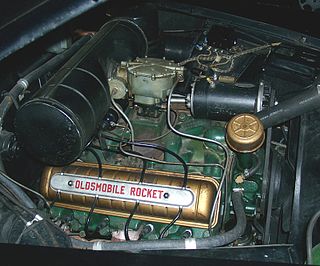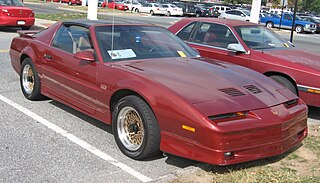Related Research Articles

Pontiac or formally the Pontiac Motor Division of General Motors, was an American automobile brand owned, manufactured, and commercialized by General Motors. Introduced as a companion make for GM's more expensive line of Oakland automobiles, Pontiac overtook Oakland in popularity and supplanted its parent brand entirely by 1933.

The Pontiac Firebird is an American automobile that was built and produced by Pontiac from the 1967 to 2002 model years. Designed as a pony car to compete with the Ford Mustang, it was introduced on February 23, 1967, five months after GM's Chevrolet division's platform-sharing Camaro. This also coincided with the release of the 1967 Mercury Cougar, Ford's upscale, platform-sharing version of the Mustang.

The Pontiac Fiero is a mid-engine sports car manufactured and marketed by Pontiac for model years 1984-1988. Designed by George Milidrag and Hulki Aldikacti as a sports car, it was the first two-seater Pontiac since the 1926 to 1938 coupes, and the first mass-produced mid-engine sports car by an American manufacturer. Progressive technologies incorporated in the Fiero design, included composite panels, unique for their time. Other features included hidden headlamps and integrated stereo speakers in the driver and passenger headrests. The Fiero was discontinued after annual sales fell steadily.

The Chevrolet S-10 is a compact pickup truck that was produced by Chevrolet. It was the first domestically built compact pickup of the big three American automakers. When it was first introduced as a "quarter-ton pickup" in 1981 for the 1982 model year, the GMC version was known as the S-15 and later renamed the GMC Sonoma. A high-performance version was released in 1991 and given the name of GMC Syclone. The pickup was also sold by Isuzu as the Hombre from 1996 through 2000, but only in North America. There was also an SUV version, the Chevrolet S-10 Blazer/GMC S-15 Jimmy. An electric version was leased as a fleet vehicle in 1997 and 1998. Together, these pickups are often referred to as the S-series.

The Chevrolet small-block engine is a series of gasoline-powered, V-8 automobile engines, produced by the Chevrolet division of General Motors between 1954 and 2003, using the same basic engine block. Referred to as a "small-block" for its size relative to the physically much larger Chevrolet big-block engines, the small block family spanned from 262 cu in (4.3 L) to 400 cu in (6.6 L) in displacement. Engineer Ed Cole is credited with leading the design for this engine. The engine block and cylinder heads were cast at Saginaw Metal Casting Operations in Saginaw, Michigan.

The Iron Duke engine is a 151 cu in (2.5 L) Straight-4 piston engine built by the Pontiac Motor Division of General Motors from 1977 to 1993. Thereafter GM's 2.2 L OHV 4-cylinder replaced it across the entire lineup of vehicles that offered it. Although its original purpose was to serve as Pontiac's new economy car engine, it was later adapted for use in a wide variety of applications across GM's lineup in the 1980s.

The General Motors 60° V6 engine family is a series of 60° V6 engines produced for both longitudinal and transverse applications. All of these engines are 12-valve cam-in-block or overhead valve engines, except for the LQ1; which uses 24 valves driven by dual overhead cams. These engines vary in displacement between 2.5 and 3.4 litres and have a cast-iron block and either cast-iron or aluminum heads. Production of these engines began in 1980 and ended in 2005 in the U.S., with production continued in China until 2010. This engine family was the basis for the GM High Value engine family. These engines have also been referred to as the X engines due to their first usage in the X-body cars.

The Buick V6, popularly referred to as the 3800 in its later incarnations, originally 198 cu in (3.2 L) and initially marketed as Fireball at its introduction in 1962, was a large V6 engine used by General Motors. The block is made of cast iron and all use two-valve-per-cylinder iron heads, actuated by pushrods. The engine, originally designed and manufactured in the United States, was also produced in later versions in Australia. It was the first six-cylinder engine designed exclusively for Buick products since the Buick straight-six was discontinued in 1930.

The GMC Typhoon is a high-performance SUV, produced from 1992 until 1993 by GMC. The Typhoon was based on the 1991 GMC Syclone.

The GMC Syclone is a high-performance version of the GMC Sonoma pickup truck. Produced in 1991 by GMC along with Production Automotive Services (PAS) - the same company credited with building the famed 1989 Pontiac Turbo Trans Am, the GMC Syclone was the quickest production truck to be produced in 1991. Following the Syclone's production, the similarly powered 1992-1993 GMC Typhoon SUV was based on the GMC Jimmy platform. Also following the Syclone, the 1992 GMC Sonoma GT truck was offered as a sport package with the looks of a Syclone but without the price and performance of its turbocharged predecessor. Only 806 Sonoma GTs were produced.

The Oldsmobile V8, also referred to as the Rocket, is series of engines that was produced by Oldsmobile from 1949 to 1990. The Rocket, along with the 1949 Cadillac V8, were the first post-war OHV crossflow cylinder head V8 engines produced by General Motors. Like all other GM divisions, Olds continued building its own V8 engine family for decades, adopting the corporate Chevrolet 350 small-block and Cadillac Northstar engine only in the 1990s. All Oldsmobile V8s were manufactured at plants in Lansing, Michigan while the engine block and cylinder heads were cast at Saginaw Metal Casting Operations.

The Quad 4s is a family of principally DOHC inline four-cylinder engines produced by General Motors' Oldsmobile division between 1987 and 2002; a single SOHC version was built between 1992 and 1994.

The 122 engine was designed by Chevrolet and was used in a wide array of General Motors vehicles. The 122 was similar to the first two generations of the General Motors 60° V6 engine; sharing cylinder bore diameters and some parts. The 122 was available in the US beginning in 1982 for the GM J platform compact cars and S-series trucks.

The Pontiac straight-6 engine is a family of inline-six cylinder automobile engines produced by the Pontiac Division of General Motors Corporation in numerous versions beginning in 1926.
Turbo-Hydramatic or Turbo Hydra-Matic is the registered tradename for a family of automatic transmissions developed and produced by General Motors. These transmissions mate a three-element turbine torque converter to a Simpson planetary geartrain, providing three forward speeds plus reverse.

Specialty Equipment Market Association (SEMA) of the automobile aftermarket was formed in 1963 by Roy Richter, Ed Iskenderian, Els Lohn, Willie Garner, Bob Hedman, Robert E. Wyman, John Bartlett, Phil Weiand Jr, Al Segal, Dean Moon, and Vic Edelbrock Jr. and now consists of 6,383 companies worldwide, bringing together aftermarket manufacturers, original equipment manufacturers (OEM), media, car dealers, specialty equipment distributors, installers, retailers and restoration specialists.
The GM A platform was a rear wheel drive automobile platform designation used by General Motors from 1925 until 1959, and again from 1964 to 1981. In 1982, GM introduced a new front wheel drive A platform, and existing intermediate rear wheel drive products were redesignated as G-bodies.

The third generation Pontiac Firebird was introduced in late 1981 by Pontiac alongside its corporate cousin, the Chevrolet Camaro for the 1982 model year. These were also the first Firebirds with factory fuel injection, four-speed automatic transmissions, five-speed manual transmissions, four-cylinder engines, 16-inch wheels, and hatchback bodies.

The Chevrolet 90° V6 family of V6 engines began in 1978 with the Chevrolet 200 cu in (3.3 L) as the base engine for the all new 1978 Chevrolet Malibu. The original engine family was phased out in early 2014, with its final use as the 4.3 L (262 cu in) V6 engine used in Chevrolet and GMC trucks and vans. Its phaseout marks the end of an era of Chevrolet small-block engine designs dating back to the 1955 model year. A new Generation V 4.3 L (262 cu in) V6 variant entered production in late 2013, based on the LT1 small block V8 used in the 2014 Chevrolet Silverado.
References
- 1 2 Thomas A. DeMauro. "1989 Pontiac Trans Am Turbo Pace Car - Indy Meets Daytona". Hot Rod Magazine. Retrieved August 8, 2006.
- ↑ McIlvaine, Jim (2005-10-07). "Time Warp T/A". Hot Rod Magazine. Retrieved Oct 7, 2005.
- ↑ "1st Annual 1989 Pontiac Trans Am Turbo Meet - The '89 Pontiac Turbo Trans Am Reunion". High Performance Pontiac Magazinefixed.